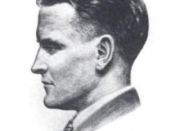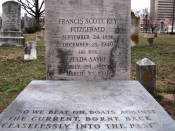F. Scott Fitzgerald demonstrates that real joy does not come from material objects and the deception that wealth will bring people happiness in his novel, The Great Gatsby. Nick Carraway, the narrator, tells about three characters that are not what they seem. A wealthy man, Jay Gatsby, spends his whole life trying to find happiness in money and material things. Daisy and Tom are fake and too careless to know what true reality is. In the novel, things may not be what they appear as shown by the illusion Gatsby lives, Daisy's attitude, and Tom's relationships.
Gatsby lives an illusion that his wealth will lead to satisfaction and friendship. Gatsby has people all around him, going to his parties, yet no one truly knows him. Born a poor man and son of a farmer, James Gatz desires living the "American dream". Because of this dream, he creates a false Identity, Jay Gatsby, "So he invented just the sort of Jay Gatsby that a seventeen year old boy would be likely to invent, and to this conception he was faithful to the end"(104).
He wastes his life trying to impress other people with material success. Gatsby is the type of person to do anything to get happiness even if it is the false kind. Jay Gatsby is man who will have it all and believes Daisy, an image of money and happiness, is a perfect fit.
Daisy presents a false personality to others in hopes they will believe she is happy. When Nick mentions his and Daisy's hometown, she cries " How gorgeous! Let's go back, Tom, tomorrow!" "You ought to see the baby" (14). The way she exaggerates everything and bounces from one subject to the next exposes her phony attitude. Nick's recognizes Daisy and Tom's faults as he...



The facade essay on "The Great Gatsby"
A very good essay on the deception of people in "The Great Gatsby." Pretty good support as well.
1 out of 1 people found this comment useful.